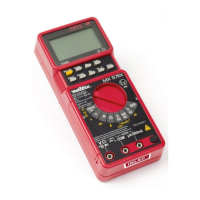Chapter II X02137C00 - Ed. 1 - 06/07
Intrinsically safe portable digital multimeter
29
2. DESCRIPTION
This multimeter is one of the ASYC II (Advanced SafetY Concept, second generation) range,
designed for a high degree of user safety, maximum protection and unrivalled performance.
2.1. Selector switch
This standalone, handheld professional measuring instrument is capable of measuring the
following quantities (accessed by the eight-position rotary selector switch) :
∗ AC voltages with AC (or RMS) capacitive coupling
∗ AC voltages with AC+DC (or TRMS) direct coupling
∗ DC voltages
∗ AC currents with AC (or RMS) capacitive coupling
∗ AC currents with AC+DC (or TRMS) direct coupling
∗ DC currents
∗ resistance values
∗ continuity (with beeper)
∗ capacitance
∗ diode threshold voltage
∗ frequencies
∗ duty cycles
∗ pulse counting
∗ pulse width
∗ dBm
∗ resistive power
∗ temperature
2.2. Keypad
An nine-key keypad lets you :
∗ select the autoranging mode (RANGE)
∗ store a value (HOLD)
∗ measure fast peaks (PK+/-)
∗ set the measurement relative to a reference value (REL)
∗ select a function derived from the main function, or switch on the multimeter again after it
has been shut down automatically (SEL/ON)
∗ select time-domain measurements: frequency, duty cycle, stopwatch, pulse counter (Hz)
∗ activate the MIN- MAX- AVG detection mode (SURV)
∗ activate sending data to a printer or a computer (PRINT)
2.3. Display
The display shows :
∗ clearly legible figures (14 mm high)
∗ an analogue readout of the parameter being measured through a 34-segment bargraph
∗ perform 50 000-point measurements (high resolution)
∗ perform 5 000-point measurements (low resolution)
2.4. Power supply
It is powered by a standard 9 V (6LF22, 6LR61) battery which provides approximately
300 hours of operation (in V
DC
mode). It is prohibited to use batteries other than those
specified (see §. 3.5.3. Replacing the battery or fuse).
2.5. Input terminals
Measurements are performed using two measuring leads supplied with the instrument connected
to input terminals 1, 2, 3 and 4, as indicated in §. 3.1.

